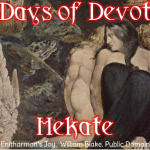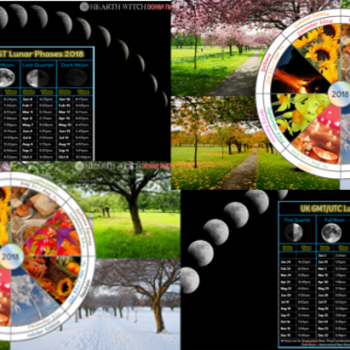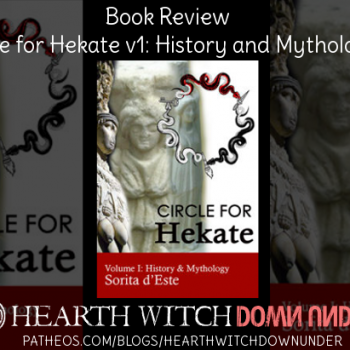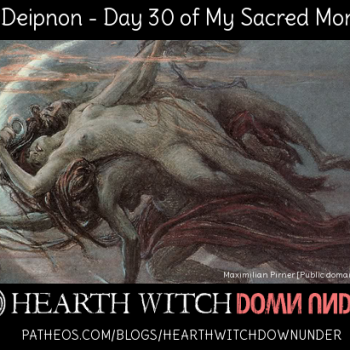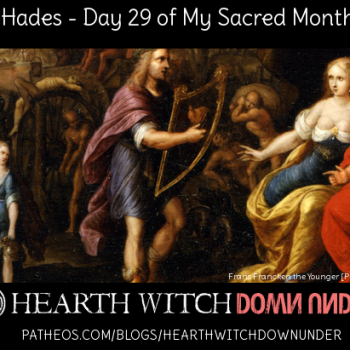This post is part of a blog challenge series – 30 Days of Devotion, to Hekate. Day 3 and we are looking at symbols and icons of Hekate.
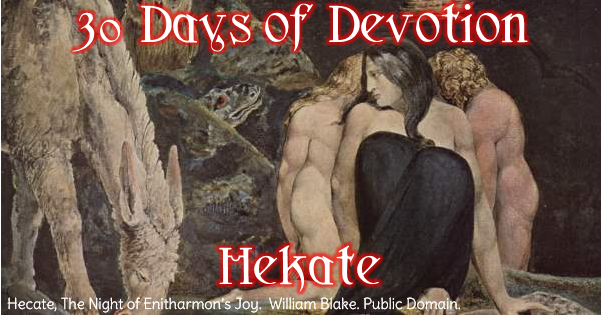
Hekate in Art
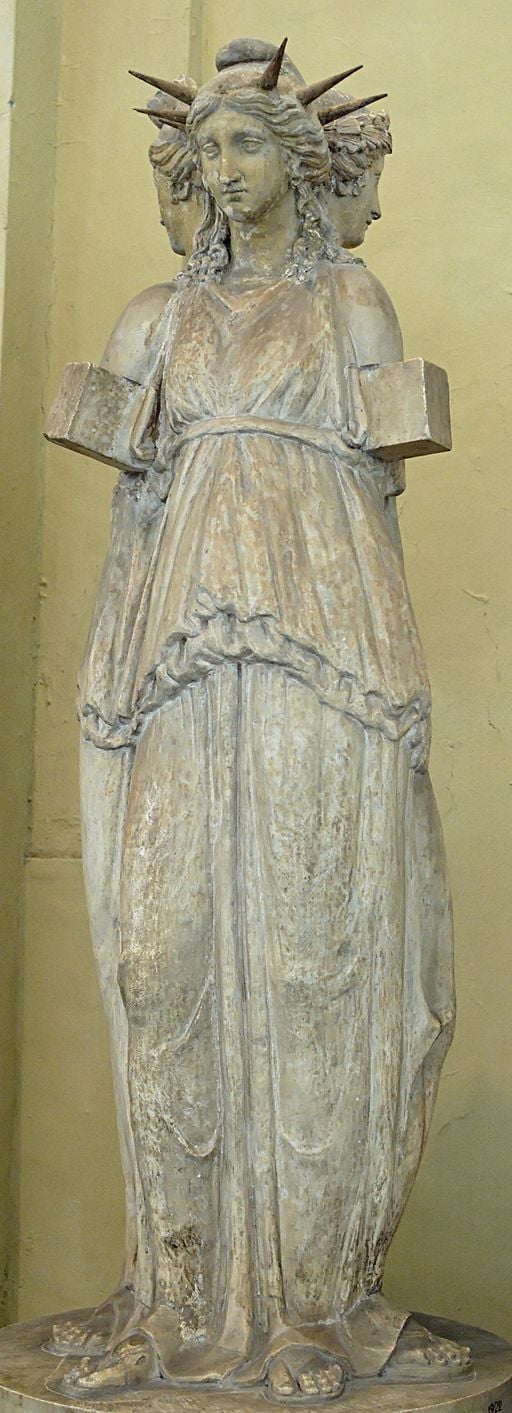
Triple Hekate
One of the more common images you will find of Hekate, both ancient and modern, is that of the Triple Hekate. Many statues from Greece and Rome show Hekate as having three bodies, all facing different directions, backs toward each other. Unlike the modern Triple Goddess, the Triple Hekate shows three women who look the same age, usually about 30 or so, perfect, beautiful and unblemished. You can see an example to the left.
Attire
Whether a single Hekate or triple Hekate, She is most often shown holding lit torches, keys, lanterns and daggers. Sometimes She can be seen holding a cord or rope, a scourge and occasionally a bow – likely due to Her common conflation with Artemis.
She is often shown wearing a crown on Her head, and just as often a crescent moon on Her head, points up evoking the idea of bulls horns.
For clothing She is often seen wearing much like what we see in the image, a long dress. But then She also seen wearing a shorter hunting dress, with long hunting boots – again much like Artemis.
In modern artistic representations, Hekate is most often shown wearing black clothing, sometimes with a touch of silver or red. Yet She is described in some myths as being saffron cloaked or robed.
Animal Headed
One of the less spoken about ways that Hekate is depicted is with the body of a woman and an animals head. You are not likely to find this mentioned in your average mythology encyclopaedia or Pagan or witch encyclopaedia or dictionary. But it is actually a little more common than you might imagine, you need only look for it and you will find it.
The types of animal heads She may have is varied – dogs are of course the most common, as they are Her animal through and through. But cow or bull, horse, snake, lion, dragon and boar are also seen or written of. There aren’t a lot of ancient arts that show such, but you can certainly find modern examples and many of them are quite beautiful.
Crone Goddess
And of course we must speak of the popular modern view of Hekate as the Crone, part of the Triple Goddess with Artemis and Selene. Silvery haired, old and wrinkled but still beautiful and somehow perfect and wise looking.
A lot of us who are devoted to Hekate do have a little trouble accepting this crone image of Her – but we also have to admit, it is not up to us how She presents Herself to others. The Theoi can show Themselves however They so choose and we have many examples of Them appearing as young, middle aged and old. We need only look at Demeter to see this – She disguises Herself as an old woman in Her search for Kore. Why can’t Hekate do the same?
Symbols of Hekate
To note, this is a mix of traditional and modern symbols, annoyingly I cannot quite remember the difference for some of them. Some I know are historical, but some I am just not sure of. Some may also be missing, these are likely food items and will be included in the Offerings post.
Animals
- Bulls
- Goats
- Hounds, dogs, and I assume wolves (possibly dingoes for us in Australia)
- Horses
- Crows/Ravens – modern, likely Morrigan connection
- Sheep, especially black ones – sacrificial
- Owls – likely Artemis conflation
- Dragons
- Lizards – via sacrifice in certain spells/curses
- Fish, red mullet especially
- Serpents/Snakes
- Polecat
- Bats – modern I think
Minerals
- Bronze
- Gold
- Iron
- Ebony
- Lapis Lazuli
- Lodestone
- Black stones/gems – likely modern, Dark-Crone Goddess
Plants
- Mandrake
- Garlic
- Aconite
- Oak
- Saffron
- Yew
- Willow
- Poplar, especially black poplar
- Dandelion – modern I think
- Any and all poisonous plants – mostly modern, but as Goddess of witches it stands
Others
- Colours: Black, Red, Silver, Gold (saffron) & White
- Torches, especially twin torches (flame ones, I don’t know about electric ones)
- Lamp
- Fire
- Knives/Daggers/Swords
- Sandals
- Whip
- Headband
- Keys
- Golden Sceptre
- Heralds Wand
- Crossroads
- Entrance Ways/Gates/Doorways
- Crescent Moon
- Dark Moon
- Virgins
- The strophalos or Hekates Wheel
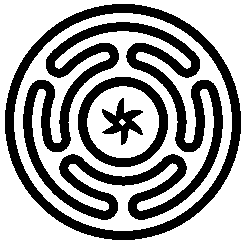
30 Days of Deity Devotion
1 – A basic introduction of the deity
2 – How did you become first aware of this deity?
3 – Symbols and icons of this deity
4 – A favourite myth or myths of this deity
5 – Members of the family – genealogical connections
6 – Other related deities and entities associated with this deity
7 – Names and epithets
8 – Variations on this deity (aspects, regional forms, etc.)
9 & 27 – Common mistakes and worst misconceptions about this deity
10 – Offerings – historical and UPG
11 – Festivals, days, and times sacred to this deity
12 – Places associated with this deity and their worship
13 – What modern cultural issues are closest to this deity’s heart?
14 – Has worship of this deity changed in modern times?
15 – Any mundane practices that are associated with this deity?
16 – How do you think this deity represents the values of their pantheon and cultural origins?
17 – How does this deity relate to other gods and other pantheons?
18 – How does this deity stand in terms of gender and sexuality? (historical and/or UPG)
19 – What quality or qualities of this god do you most admire? And find the most troubling?
20 & 21 – Art and music that reminds you of this deity
22 – A quote, a poem, or piece of writing that you think this deity resonates strongly with
23 – Your own composition – a piece of writing about or for this deity
24 & 25 – A time when this deity has helped you, and refused to help
26 – How has your relationship with this deity changed over time?
28 – Something you wish you knew about this deity but don’t currently
29 – Any interesting or unusual UPG to share?
30 – Any suggestions for others just starting to learn about this deity?


